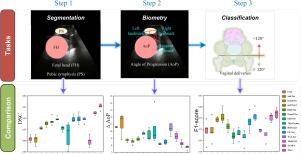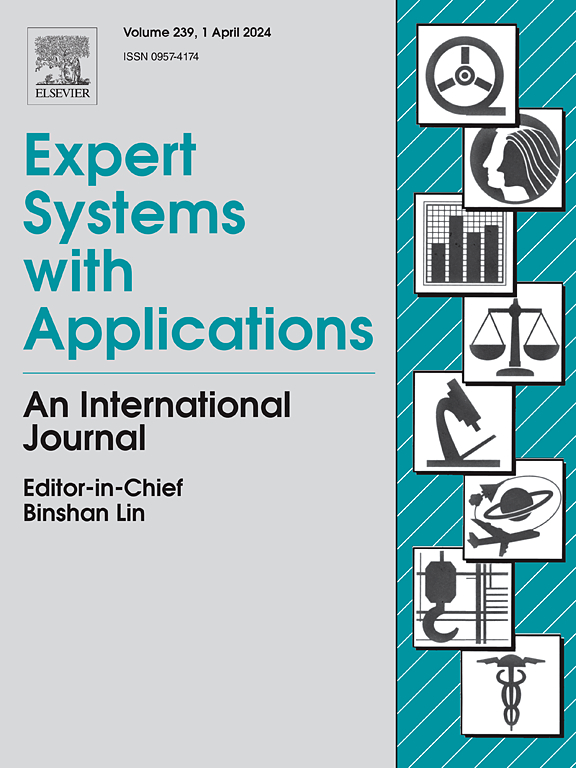Segment Anything Model for fetal head-pubic symphysis segmentation in intrapartum ultrasound image analysis
IF 7.5
1区 计算机科学
Q1 COMPUTER SCIENCE, ARTIFICIAL INTELLIGENCE
引用次数: 0
Abstract
The Angle of Progression (AoP), determined by the contour delineations of the pubic symphysis and fetal head (PSFH) in intrapartum ultrasound (US) images, is crucial for predicting delivery mode and significantly influences labor outcomes. However, automating AoP measurement based on PSFH segmentation remains challenging due to poor foreground-background contrast, blurred boundaries, and anatomical variability in shapes, sizes, and positions during labor. We propose a novel Segment Anything Model (SAM) framework, AoP-SAM, designed to enhance the PSFH segmentation, AoP measurement and outcome prediction, tackling the challenges of small target segmentation and accurate boundary segmentation. It synergistically combines CNNs and Transformers within a cooperative encoder to process complex spatial relationships and contextual information to segment the PSFH. In this encoder, we devise a multi-scale CNN branch to capture intrinsic local details, which compensates for the defects of the Transformer branch in extracting local features. Further, a cross-branch attention module is applied to improve prediction by fostering the effective information exchange and integration between two branches. Evaluations on the benchmark dataset demonstrate that our method achieves state-of-the-art (SOTA) performance. Specifically, in the PSFH segmentation task, the AoP measurement task, and the AoP classification task, we achieved a DSC of 0.8745 on the PS structure, a AoP of 7.6743°, and an F1-score of 0.7719, respectively. Compared to the second-ranking method, these results represent improvements of 2.5%, 6.3%, and 1.1%. Our study presents a framework for intrapartum biometry, offering significant advancements in labor monitoring and delivery mode prediction in clinical settings. Future efforts will focus on optimizing AoP-SAM for resource-constrained environments, highlighting its potential for lightweight adaptation. https://github.com/maskoffs/AoP-SAM.

用于产前超声图像分析中胎儿头-耻骨联合分割的 "任何分割 "模型
耻骨联合和胎头(PSFH)在产前超声(US)图像中的轮廓划分决定了产程进展角(AoP),它对预测分娩方式至关重要,并对分娩结果有重大影响。然而,由于前景-背景对比度差、边界模糊以及分娩过程中形状、大小和位置的解剖变异,基于 PSFH 分割的 AoP 自动测量仍具有挑战性。我们提出了一种新颖的 "任意分割模型"(Segment Anything Model,SAM)框架,即 AoP-SAM,旨在增强 PSFH 分割、AoP 测量和结果预测,解决小目标分割和精确边界分割的难题。它将 CNN 和变换器协同结合到一个合作编码器中,以处理复杂的空间关系和上下文信息,从而分割 PSFH。在该编码器中,我们设计了一个多尺度 CNN 分支来捕捉固有的局部细节,从而弥补了 Transformer 分支在提取局部特征方面的缺陷。此外,我们还应用了跨分支关注模块,通过促进两个分支之间的有效信息交换和整合来改进预测。在基准数据集上进行的评估表明,我们的方法达到了最先进(SOTA)的性能。具体来说,在 PSFH 分割任务、AoP 测量任务和 AoP 分类任务中,我们在 PS 结构上分别取得了 0.8745 的 DSC 值、7.6743° 的 ΔAoP 值和 0.7719 的 F1 分数。与二级排序法相比,这些结果分别提高了 2.5%、6.3% 和 1.1%。我们的研究提出了产中生物测量的框架,为临床环境中的产程监测和分娩方式预测提供了重大进展。未来的工作重点是针对资源有限的环境优化 AoP-SAM,突出其轻量级适应的潜力。https://github.com/maskoffs/AoP-SAM。
本文章由计算机程序翻译,如有差异,请以英文原文为准。
求助全文
约1分钟内获得全文
求助全文
来源期刊

Expert Systems with Applications
工程技术-工程:电子与电气
CiteScore
13.80
自引率
10.60%
发文量
2045
审稿时长
8.7 months
期刊介绍:
Expert Systems With Applications is an international journal dedicated to the exchange of information on expert and intelligent systems used globally in industry, government, and universities. The journal emphasizes original papers covering the design, development, testing, implementation, and management of these systems, offering practical guidelines. It spans various sectors such as finance, engineering, marketing, law, project management, information management, medicine, and more. The journal also welcomes papers on multi-agent systems, knowledge management, neural networks, knowledge discovery, data mining, and other related areas, excluding applications to military/defense systems.
 求助内容:
求助内容: 应助结果提醒方式:
应助结果提醒方式:


